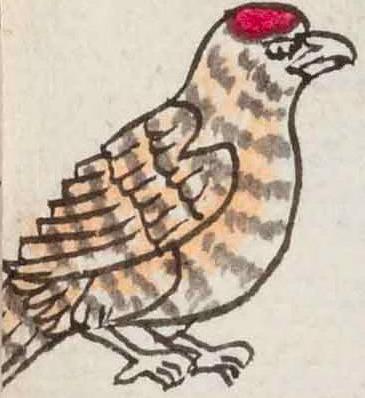Molotla (Mdz23r)
This simplex glyph for the place name, Molotla, is a representation of a common house finch (molotl). The finch, facing to our right in profile, has light orange and gray-brown stripes, and it has a bright red patch on the top of its head, which calls attention to the likely precious feathers. The locative suffix (-tla or -tlah) is not shown visually.
Stephanie Wood
The common house finch can also have a red breast, but the red head is emphasized here. The red head also gives it the name cuachichil in the Florentine Codex (see Book XI). The -tla suffix (as shown in the gloss) could involve an inadvertent dropping of the final n. The difference is not great; -tla means place of abundance of, and -tlan means place of.
Frances Karttunen sees this bird as a ruby-crowned kinglet. [Frances Karttunen, unpublished manuscript, used here with her permission.]
Stephanie Wood
molotla.puo
Molotla, pueblo (or possibly Molotlan)
Stephanie Wood
c. 1541, or by 1553 at the latest
Stephanie Wood
birds, feathers, pájaros, plumas, pinzones, nombres de lugares

molo(tl), a common house finch, https://nahuatl.wired-humanities.org/content/molotl
-tla (locative suffix), place of abundance of, https://nahuatl.wired-humanities.org/content/tla-1
-tlan (locative suffix), place, https://nahuatl.wired-humanities.org/content/tlan
"Where There Are Many Common House Finches" (Berdan and Anawalt, 1992, vol. 1, p. 194)
"El Lugar del Pinzón"
Codex Mendoza, folio 23 recto, https://digital.bodleian.ox.ac.uk/objects/2fea788e-2aa2-4f08-b6d9-648c00..., image 56 of 188.
The Bodleian Libraries, University of Oxford, hold the original manuscript, the MS. Arch. Selden. A. 1. This image is published here under the UK Creative Commons, “Attribution-NonCommercial-ShareAlike 3.0 License” (CC-BY-NC-SA 3.0).


